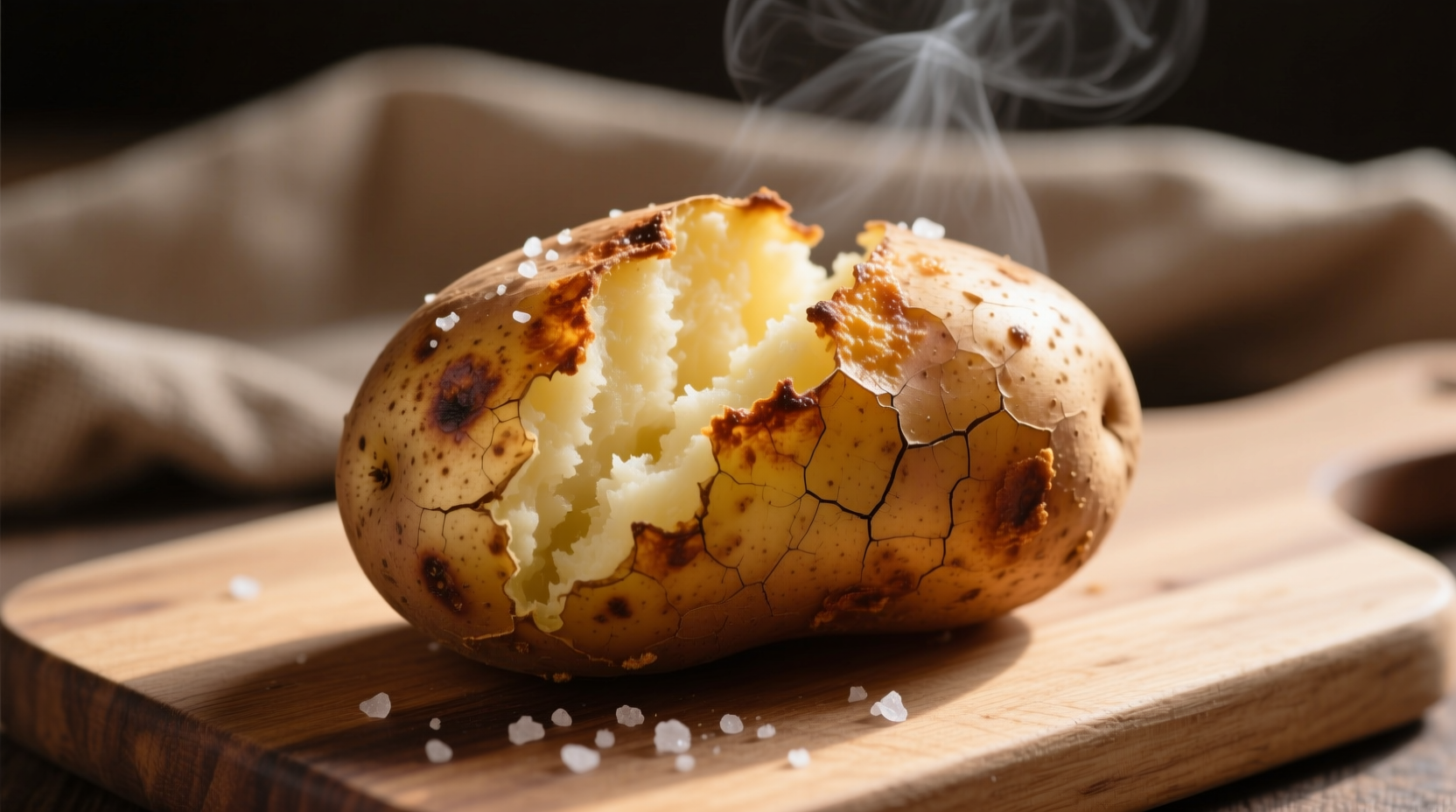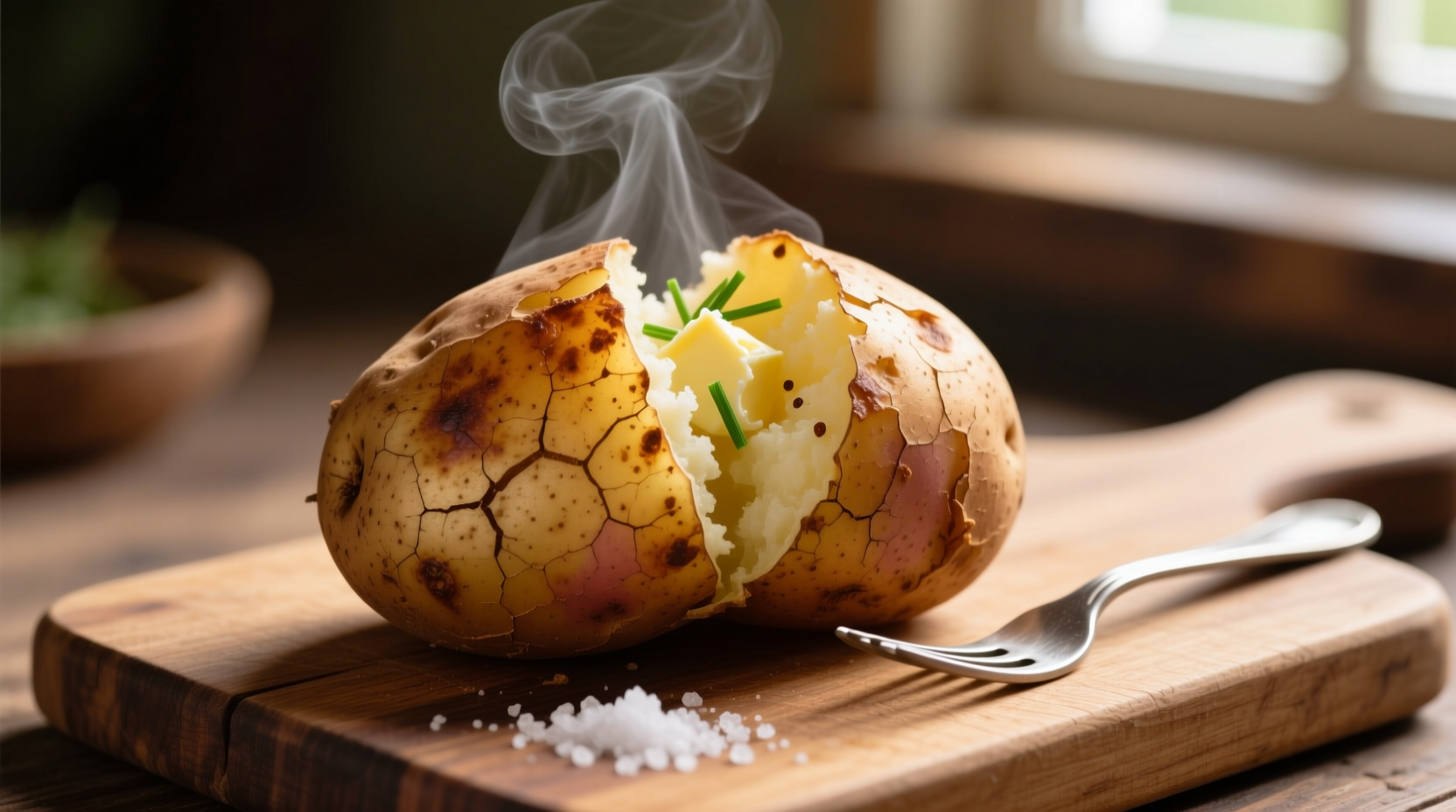Forget dry, unevenly cooked potatoes forever. This guide reveals the science-backed method professional chefs use to achieve consistently perfect baked potatoes with crispy skin and cloud-like interiors. Whether you're cooking for a weeknight dinner or special occasion, these techniques transform a humble spud into a showstopper.
Why Your Baked Potatoes Fail (And How to Fix It)
Most home cooks make three critical mistakes that sabotage their baked potatoes:
- Skipping the drying step - Moisture on the skin creates steam, preventing crispiness
- Using the wrong potato variety - Not all potatoes behave the same when baked
- Incorrect temperature monitoring - Guessing doneness leads to undercooked centers or burnt skins
Food science explains why these errors matter. Potatoes contain starch granules that need to reach 205-210°F to fully gelatinize, creating that signature fluffy texture. Below this temperature, your potato remains dense and undercooked.
The Potato Selection Guide: Choosing Your Foundation
Not all potatoes are created equal for baking. Understanding starch content is crucial:
| Potato Variety | Starch Content | Best For | Not Recommended For |
|---|---|---|---|
| Russet (Idaho) | High (22-24%) | Classic fluffy baked potatoes | Salads (becomes too crumbly) |
| Yukon Gold | Medium (18-20%) | Creamy texture, buttery flavor | When maximum fluffiness needed |
| Red Potatoes | Low (15-17%) | Boiling, roasting with skin | Traditional baked potato preparation |
According to USDA agricultural research, russets' high starch content and thick skin make them ideal for baking, as they convert starch to sugar more efficiently during cooking, enhancing flavor development (USDA Agricultural Research Service).
Step-by-Step Perfect Baked Potato Method
Preparation: The Critical First Steps
- Clean thoroughly - Scrub with vegetable brush under cold water
- Dry completely - Pat with paper towels, then let air dry 15 minutes
- Prick strategically - 8-10 shallow pricks with fork (prevents bursting)
- Oil lightly - Rub with 1/2 tsp oil per potato (helps crisp skin)
- Salt surface - Coarse salt enhances crispiness through moisture absorption
Baking Process: Precision Temperature Control
Place potatoes directly on oven rack with baking sheet on lower rack to catch drips. Bake at 400-425°F following these time guidelines:
- Medium (6-8 oz): 45-50 minutes
- Large (8-10 oz): 50-55 minutes
- X-Large (10+ oz): 55-65 minutes
The definitive test? Insert an instant-read thermometer into the center - it should read 205-210°F. This precise temperature ensures complete starch gelatinization for maximum fluffiness.

Topping Strategies: Beyond Butter and Sour Cream
While classic toppings work, these professional combinations elevate your baked potato:
Classic Reinvented
- Loaded Baked Potato - Crispy bacon, sharp cheddar, chives, and a touch of hot sauce
- Chive & Crème Fraîche - More sophisticated than sour cream with subtle tang
Global Inspirations
- Mexican Street Corn Style - Cotija cheese, chili powder, lime zest, cilantro
- Mediterranean Herb - Kalamata olives, feta, roasted garlic, oregano
- Asian Fusion - Furikake, scallions, sesame oil, pickled ginger
Nutritional Profile: The Healthy Truth About Baked Potatoes
Contrary to popular belief, baked potatoes are nutritional powerhouses when prepared correctly. According to USDA FoodData Central, a medium (150g) russet potato with skin provides:
- 168 calories
- 4.3g fiber (17% of daily value)
- 620mg potassium (18% of daily value)
- 27mg vitamin C (30% of daily value)
- Natural complex carbohydrates for sustained energy
The skin contains nearly half the fiber and significant nutrients, so always bake with skin intact. Pair with protein-rich toppings to create a balanced meal that stabilizes blood sugar.
Troubleshooting Common Baked Potato Problems
Problem: Soggy Skin
Solution: Ensure potatoes are completely dry before baking. Place directly on oven rack (not baking sheet) to allow air circulation. For extra-crispy skin, increase oven temperature to 425°F during last 15 minutes.
Problem: Dense, Undercooked Center
Solution: Always check internal temperature (205-210°F). Larger potatoes may need additional time. Avoid wrapping in foil, which traps moisture and creates steamed texture.
Problem: Bursting Potatoes
Solution: Prick 8-10 shallow holes with fork before baking. Don't skip this step - built-up steam needs escape routes. Place potatoes on baking sheet during first 20 minutes if concerned about mess.
When to Choose Alternative Cooking Methods
While traditional oven baking produces the best results, these alternatives work in specific contexts:
- Air Fryer (390°F for 40-45 minutes) - Excellent for single servings with ultra-crispy skin
- Grill (indirect heat, 400°F) - Adds smoky flavor, ideal for outdoor cooking
- Slow Cooker (high for 3-4 hours) - Convenient but produces softer skin
Never microwave as the sole cooking method if you want crispy skin - it creates a steamed texture. However, microwaving for 5-7 minutes before finishing in oven cuts total cooking time while preserving texture.
Perfect Baked Potato Timeline: From Andes to Your Table
The journey of the potato reveals why proper preparation matters:
- 8000 BCE - First domesticated in Andes Mountains
- 1530s - Introduced to Europe by Spanish conquistadors
- 1719 - First brought to North America (Londonderry, New Hampshire)
- 1802 - First served in White House (Thomas Jefferson)
- 1922 - Russet Burbank variety developed, becoming baking standard
- 1950s - Baked potatoes gain popularity as restaurant side dish
Understanding this history explains why russets became the baking standard - their high starch content developed through selective breeding specifically for fluffy texture when cooked.
Expert Tips for Next-Level Results
- Rest before cutting - Let potatoes rest 5-7 minutes after baking for optimal texture
- Score the top - Cut an "X" across the top to help steam escape when opening
- Fluff properly - Use fork to lift and separate flesh without mashing
- Season inside - Sprinkle salt and pepper directly into the fluffed potato
- Temperature matters - Add cold toppings to hot potato to prevent sogginess
Conclusion: Mastering the Humble Baked Potato
With these science-backed techniques, you'll consistently create bakery-quality baked potatoes at home. The perfect balance of crispy skin and fluffy interior transforms this simple ingredient into a memorable dish. Remember that attention to drying, temperature control, and proper resting time makes all the difference. Whether you're preparing a weeknight side or elegant dinner centerpiece, these methods guarantee success every time.
How do I get crispy skin on baked potatoes?
For crispy skin, thoroughly dry potatoes before baking, rub with oil and coarse salt, and bake directly on oven rack at 400-425°F. Avoid wrapping in foil, which traps moisture. The salt draws out moisture while the oil helps conduct heat for maximum crispiness.
What's the ideal internal temperature for a baked potato?
The ideal internal temperature for a perfectly baked potato is 205-210°F (96-99°C). At this temperature, starch granules have fully gelatinized, creating maximum fluffiness. Use an instant-read thermometer inserted into the center for accurate measurement.
Should I wrap potatoes in foil when baking?
No, wrapping potatoes in foil creates a steamed texture rather than baked. Foil traps moisture against the skin, preventing crispiness and resulting in a boiled potato texture. For authentic baked potato texture with crispy skin, always bake potatoes uncovered directly on the oven rack.
How long do baked potatoes stay hot after cooking?
Baked potatoes stay hot for approximately 30-45 minutes when wrapped in a clean kitchen towel or placed in an insulated container. For restaurant-style holding, keep at 140°F or above in a warming drawer. Avoid leaving at room temperature longer than 2 hours for food safety.
Can I bake potatoes ahead of time?
Yes, you can bake potatoes ahead of time. After baking, let them cool slightly, then store in refrigerator for up to 3 days. To reheat, place directly on oven rack at 350°F for 15-20 minutes until heated through. For best results, brush with oil before reheating to restore crispiness.











 浙公网安备
33010002000092号
浙公网安备
33010002000092号 浙B2-20120091-4
浙B2-20120091-4